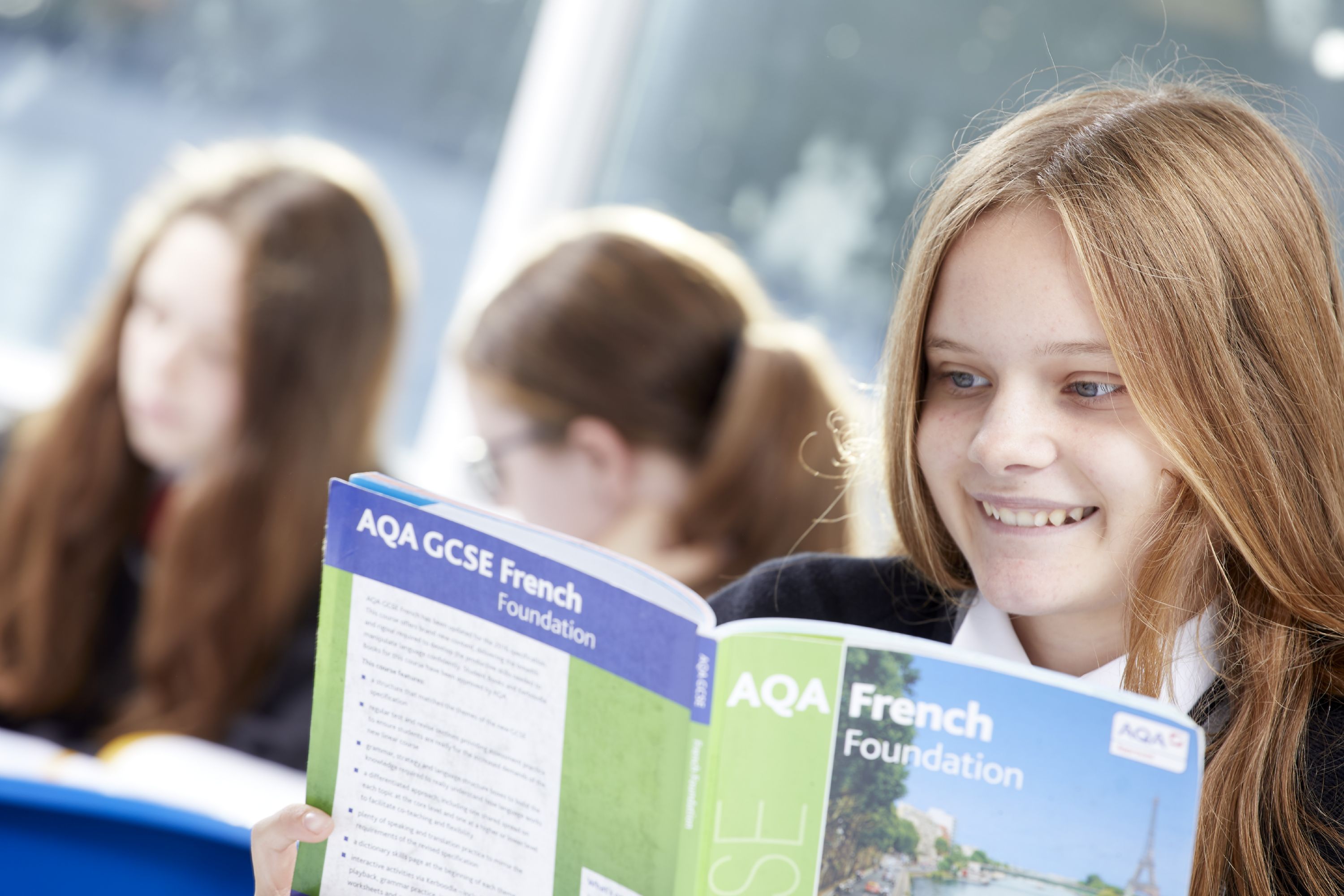Our History
Cottingham High School was originally named Cottingham Secondary School and was established in the late 1950s as a Modern Secondary School by the terms of the 1944 Education Act. This Act promised secondary education for all young people. The school leaving age was then 15.
Prior to this time, older pupils from Cottingham (up to 14 years before 1944) had either stayed at Hallgate County School until they left school, or, if they had won a scholarship they attended either Beverley High School or Beverley Boys Grammar School – both single sex secondary schools.
The school’s first headmaster was the late Eric Greenwood. He served the school and wider community until his well-earned retirement at Christmas 1971. In September 1973, the school was re-named Cottingham High School, reinforcing its new status as a comprehensive secondary school. On April 1st 1974, the East Riding of Yorkshire County Council was replaced by Humberside County Council with Cottingham High School under the control of Humberside Education Authority.
A series of national Education Acts instigated by the Conservative Government in the 1980s and early 1990s reduced the influence of local education authorities and local management of schools gave rise to an annual devolved budget allocated to schools. Cottingham High School, like all state schools now, had more independence and responsibility, particularly in administering its own budget.
On April 1st 1996, Humberside County Council was abolished and, following the recommendation of the Boundary Commission, was replaced by four unitary authorities with a two-tier structure for local Government. Cottingham High School became one of 18 state secondary schools in the area of the East Riding LEA.
The site
Cottingham High School is sited on the north-western edge of Cottingham – once a large village and now a suburban community. The road running along the western boundary of the site is now called Harland Way. In the late eighteenth century, this was the southern section of the Cottingham to Beverley turnpike road with a toll gate just beyond the outer edge of the current school playing field.
The school site comprises two, separate complexes: one built in the 1950s the other when the school expanded in the late 1970s. The school gardens date from a Georgian residence previously on the site and evidence of the garden management related to this house and grounds can still be seen in the planting arrangement and variety of trees in the school grounds.
In the Middle Ages, the present school grounds formed part of a royal hunting forest, which was enjoyed by the Prior of the Minster of St John, Beverley and their royal visitors – the status being preserved in the name Beverley Parks. From the 16th to late 18th centuries, the site of the school was the North East corner of Westfield – one of Cottingham’s three large arable open fields. Looking East from the strips of Westfield, one would have seen the uninterrupted expanse of Cottingham common land stretching across the River Hull flood plain to the present embanked course of the river, which would have been partially inundated in times of high rainfall or Spring tide.
Cottingham Grange
Following enclosure in 1793, the site became an enclosed field. In 1800, a 9 ½ acre close was bought by a prosperous Cottingham land dealer and merchant. In 1802, a large house was built in the late Georgian style and the grounds were embarked in the fashion of the day. The house was called Cottingham Grange. Research at the County Archive Office in Beverley indicates that the various families who lived in the 19th century were wealthy and employed a number of household servants.
War service
By the late 1930s, Cottingham Grange had fallen into disrepair. However, during the Second World War, it was requisitioned by the War Ministry to be used for offices and officer’s quarters. In the South East of the grounds, large numbers of nissen huts were built as barracks for trainee infantrymen. The last of these was used by the school gardeners as a storage area until the 1980s when it was demolished.
A new and ‘Modern’ school
At some point after the war, Cottingham Grange was demolished. Records show that, by 1950-51, the East Riding County Council Education Committee was planning a new four form entry secondary school to be built on the site. Secondary modern schools were a product of the 1944 Education Act, which promised secondary education for all young people from the ages of 11 to 15. Those 11 year olds from Cottingham who passed the 11+ exam would go on to Beverley High (girls) or Beverley Grammar (boys) schools while the remainder would attend the new Modern School at Cottingham.
The minutes of the County Education Committee for September, 1950, record that part of the site had 30 ‘hutments’ (nissen huts) owned by Hull University College for accommodating students and the school grounds were to be carved from the Western side of the Grange’s grounds, adjacent to Harland Way. The 5.7 acres formally acquired by Hull University in 1952 was used to build a series of architectural award winning Halls of Residence still seen today to the east of the main school playing field.
After some delay, the new secondary school opened on 25 April 1955, with 297 pupils on roll. Since the late 1970s this part of the present day school has been known as the ‘Old Block’, but for over 20 years, it was the whole school. Built to a steel frame and box section construction (like most 1950s modern secondary schools), the building still retains many original features, including the metal window frames, parquet flooring and ceiling and aisles in the assembly hall. The external brickwork, wide corridors and enduring flat roof stand as testimony to the high building standards imposed by local authorities at that time. They were proud of their new flagship buildings which heralded the age of secondary education for all. The school also acquired an outdoor swimming pool in the late 1950s, which is now filled in to form an additional car park.
Growth, decline then growth again
With the coming of comprehensive education, the raising of the school leaving age and the expansion of Cottingham’s population, the number of pupils rose from about 300 in 1955 to 1,600 by 1979. This expansion in numbers was concentrated in the 1970s. To provide accommodation, pasture land was bought to the west of the original site. In September 1975, a new Science/Technical block was completed along with a second gymnasium and new sports hall. In 1978, a new Humanities/Modern Languages block was completed along with a Sixth Form block on land between the Old Block and New Blocks.
During the 1980s, with a declining birth rate, the school population fell with corresponding staff reductions from the 1979 peak of about 100. Increased parental choice since the early 1990s has resulted again in a growth in the school’s population. We now have over 1,000 students and over 100 members of staff.
Change within the school
This brief history cannot detail all the organisational changes that have taken place since the late 1950s. The general trend has been, as in all state secondary schools, for the independence of the original modern school to be eroded initially by local authority standardisation and, especially since the onset of the National Curriculum, by national standardisation. This trend has been aimed at making all schools more efficient and more accountable, but some might argue individuality and character have been squeezed out.
With one of the primary functions of any school being the need to meet the social and learning needs of all students, Cottingham High School reflects changing philosophies in addressing this key objective.
For almost 20 years, the Modern School had a House system with each form being a separate House and each named after constellations. Interestingly, each House had a mix of students from ages 11 to 16 registered together, single sex, and competing with others on sports days. Academically, the school was divided into departments with heads of departments immediately below deputy heads (two) in the organisational hierarchy. The first Headmaster, the late Eric Greenwood MA, oversaw the development of Cottingham Secondary School in collaboration with the Governing Body for the County Secondary School and County Primary Schools’, which was chaired for 24 years until 1978 by the late Norman Bisby, MBE, DL. Initially, Cottingham Secondary School served as the secondary school for Hallgate Council School, but by the mid 1970s, six further feeder primary schools existed: Bacon Garth, Westfield, Croxby, Skidby, Little Weighton and Dunswell.
In 1972, the then new Headmaster, Clive Whyley BA, initiated a year-based pastoral system and the Heads of Year system. This system is still in place with mixed gender and ability tutor groups being formed from the start of what we currently call Year 7.
September 1973 saw the school’s first comprehensive intake of students and for almost 30 years the year system of pastoral organisation has served their personal needs and encouraged their development. In the 1970s and early 80s, the students learning needs were served by a developing mix of departments and faculties.
In 1976, Miss K Beeson and Mr Harry Dean both retired, having been Deputy Head Teachers since the opening of the new secondary school in 1955. Both planted a conifer tree to mark the occasion. The one planted by Miss Beeson flourishes (2002). It is said that the one planted by Harry partially died back at the time of his death in 1990. The remainder of the tree died back at the time of his wife’s death a few years later.
In 1988, the school’s third headmaster, Michael Mahoney established a faculty structure. A booklet commemorating the Silver Jubilee of Cottingham High School was published in 1980 by Mrs Los, Mrs Howlett and Mr Stamp. The school retains a number of copies. In Summer 1994, Mrs Pamela Child took up the position of Head at Cottingham High School.
During her seven year Headship, a streamlined consultation process took effect, the school responded to a succession of government initiatives (both from the Conservatives up to 1997 and from Labour thereafter) and won a number of awards emphasising the quality of teaching and learning. Despite competition from West Hull’s Sixth Form College (following Hull School’s reorganisation in the late 1980s), the numbers of students in Cottingham High School Sixth Form rose rapidly by the end of the century. The school became oversubscribed in an age of parental choice and by the turn of the century, up to 40% of students were from outside the initial catchment area of Cottingham High School.
Following the recommendations of a successful Ofsted report on the school in October 1998, a further building extension programme was instituted. In March 2002, Alan Plater, whose children had attended the school in the 1970s, officially opened the new Drama/Music block – an extension of the pre-existing Sixth Form block. This imposing building radically changed the roofline of the site and provides facilities that are second to none. At the same time, two new Science laboratories were opened and what had previously been the two old block dining rooms were converted to an ultra-modern resources area incorporating the school library. These rooms formed a suite of upgraded classrooms delivering I.C.T. across the curriculum. An extension to the west of the 1970s dining room enabled it to accommodate lunchtime facilities.
Following Mrs Child’s retirement in 2001, the two deputy heads, Paul Hill (in post since 1984) and Gary Barber (in post since late 1990s), became joint Acting Head Teachers. Mr Darbyshire took up the post of Headteacher in June 2002.
Mr Darbyshire was the Headteacher from 2002 to 2010. In 2004 Cottingham High School was awarded Media Arts College status. The additional funding this brought to the school was used for significant upgrades of existing ICT systems, investment in specialist equipment for all faculties and curriculum development using media arts as the vehicle for enhancing teaching and learning.
In 2005 the school celebrated its Golden Jubilee with a special yearbook, celebrations and a Saturday Open Day for all ex-Pupils and staff. During 2005 the school formed its first links with Kwabeng Anglican Senior High Technical School, Ghana.
The school was inspected by Ofsted in 2004 and 2007 and was judged to be ‘good with some outstanding features’. During this time the school received an award from OFSTED and one from the Technology College Trust for student examination performance. The Traveller Education Trust also presented an award to the school for its work with Traveller students.
The School site was extensively remodelled in 2008 to improve students’ safety by providing better separation of children from vehicles. Control barriers were introduced for adults requiring access to school premises during the school day. Work to improve disabled access to all parts of the school buildings took place during 2009 -10.
Mrs Logan took up the post in September 2010, followed by Mr Ratheram in 2013 then Mr Wilson started in 2018. The current headteacher, Mr Kerby, joined the school in January 2024 starting a new chapter in the school's rich history.
Today
The support staff of the school has increased in numbers and, it can be argued, importance. It is hard to imagine that Cottingham Secondary School was originally looked after by just a school clerk, the famous Mrs E M Newlove, a caretaker, two gardeners and dinner ladies. Looking back, it is poignant to reflect on the passing of some departments, whether made redundant by external standardisation or market forces. Rural Science and Gardening, Art and Craft, Gender Based Technical subjects and specific non-academic courses, such as ‘Towards Tomorrow’ have gone along with their students and teachers.
Cottingham High School continues to change and adapt and inevitably staff and students alike are consumed by the demands of the moment. But reflection can bring both wisdom and joy, appreciating the present in the context of a broader canvas aids understanding and happiness.




